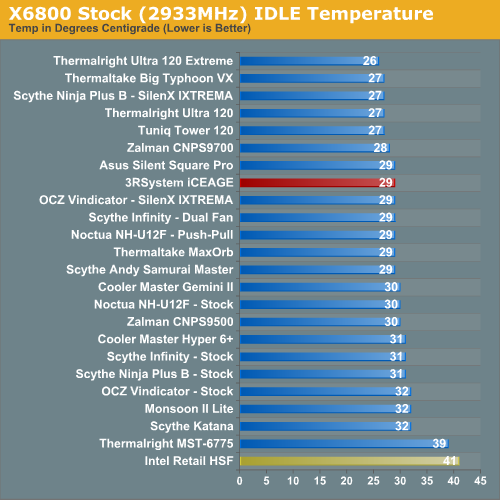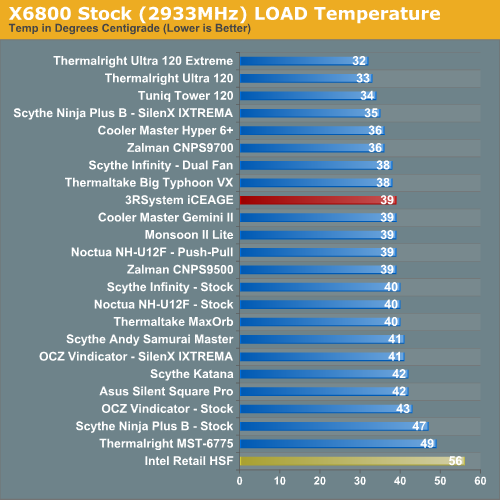3RSystem iCEAGE: A New Cooling Company Tackles the Heatpipe Tower
by Wesley Fink on June 21, 2007 12:02 AM EST- Posted in
- Cases/Cooling/PSUs
Cooling at Stock Speed
Some users will never overclock their CPU, but they still want to run the coolest CPU temperatures possible to enhance stability and extend CPU life. The 3RSystem iCEAGE comes with a high-quality slot-mounted rheostat coupled to a high-output fan. Therefore we tested the iCEAGE with the supplied fan and rheostat.

Where the very good Intel stock cooler keeps the X6800 at 41C at idle, the iCEAGE managed 29C, which is among our top performers. This is a significant improvement over the Intel stock cooler performance at 41C, and results are 3C short of the best we have tested. The Thermalright coolers, at the top of our heatpipe tower performance charts, cool to 26C and 27C, and the Tuniq 120 maintains 27C. The iCEAGE is competitive in cooling at stock idle speed.
It is more difficult to effectively simulate a computer being stressed by all of the conditions it might be exposed to in different operating environments. For most home users CPU power is most taxed with contemporary gaming. Therefore our stress test simulates playing a demanding game.
The Far Cry River demo is looped for 30 minutes and the CPU temperature is captured at 4 second intervals with the NVIDIA Monitor "logging" option. The highest temperature during the load test is then reported. Momentary spikes are ignored, as we report a sustained high-level temp that you would expect to find in this recording configuration. This test configuration roughly equates to an 80% CPU load test using Intel TAT.
Cooling efficiency of the 3RSystem iCEAGE is then compared under load conditions at stock speed to the retail HSF and other recently tested CPU coolers.

The iCEAGE under load at stock speeds reached a maximum temperature of 39C with the included fan at highest speed. This compares to the Thermalrights at 32C and 33C, the Tuniq at 34C and the Cooler Master Hyper 6+ and Zalman 9700 at 36C. Stock load performance is average at best among tested coolers.
We strongly suspect results with the iCEAGE would have been comparable to the Scythe Infinity had we been able to mount two fans in a push-pull configuration. However, 3RSystems will need to slightly modify the cooling fins to allow the option of two-fan mounting.
Some users will never overclock their CPU, but they still want to run the coolest CPU temperatures possible to enhance stability and extend CPU life. The 3RSystem iCEAGE comes with a high-quality slot-mounted rheostat coupled to a high-output fan. Therefore we tested the iCEAGE with the supplied fan and rheostat.

Where the very good Intel stock cooler keeps the X6800 at 41C at idle, the iCEAGE managed 29C, which is among our top performers. This is a significant improvement over the Intel stock cooler performance at 41C, and results are 3C short of the best we have tested. The Thermalright coolers, at the top of our heatpipe tower performance charts, cool to 26C and 27C, and the Tuniq 120 maintains 27C. The iCEAGE is competitive in cooling at stock idle speed.
It is more difficult to effectively simulate a computer being stressed by all of the conditions it might be exposed to in different operating environments. For most home users CPU power is most taxed with contemporary gaming. Therefore our stress test simulates playing a demanding game.
The Far Cry River demo is looped for 30 minutes and the CPU temperature is captured at 4 second intervals with the NVIDIA Monitor "logging" option. The highest temperature during the load test is then reported. Momentary spikes are ignored, as we report a sustained high-level temp that you would expect to find in this recording configuration. This test configuration roughly equates to an 80% CPU load test using Intel TAT.
Cooling efficiency of the 3RSystem iCEAGE is then compared under load conditions at stock speed to the retail HSF and other recently tested CPU coolers.

The iCEAGE under load at stock speeds reached a maximum temperature of 39C with the included fan at highest speed. This compares to the Thermalrights at 32C and 33C, the Tuniq at 34C and the Cooler Master Hyper 6+ and Zalman 9700 at 36C. Stock load performance is average at best among tested coolers.
We strongly suspect results with the iCEAGE would have been comparable to the Scythe Infinity had we been able to mount two fans in a push-pull configuration. However, 3RSystems will need to slightly modify the cooling fins to allow the option of two-fan mounting.










31 Comments
View All Comments
STL - Friday, June 22, 2007 - link
A couple of suggestions:1. One of the most important things about any heatsink is its mounting system, but this article (like other AnandTech reviews) has no detailed photos of how the heatsink mounts to the motherboard.
"That's like the only thing that matters!", I scream in agony.
Such photos are somewhat difficult to take, but a few good macro shots can vastly improve a review.
2. Will AnandTech ever review the Enzotech Ultra-X? It's a down-blowing 120mm heatsink with four 8mm heatpipes (larger than the usual 6mm). It also has a bolt-through-board-to-backplate mounting system with spring thumbscrews, making four points of contact with the base - i.e. ABSOLUTE HEAVEN, at least on Socket 775. (These three criteria don't seem to be satisfied by *any* other modern heatsink. The old Swiftech MCX-4000 was bolt-through-board, spring screws, four points of contact with the base - although it had no backplate, thus exerting bending force on the board.)
I decided on the Ultra-X after reading horror stories about the Ultra 120 Extreme's tendency to not stay flush with the heatspreader, since it's held down by only one point of contact to the base.
It would be nice to see an AnandTech review that acknowledged the importance of the mounting system, and that the Ultra 120 Extreme isn't perfect.
strikeback03 - Friday, June 22, 2007 - link
Technically, a plane is defined by three points, so adding a 4th is next to impossible without one point being out-of-plane. So a 3 point mounting system would be the most flat.IIRC the Tuniq uses 4 thumbscrews with springs to bolt through the board to a backplate.
STL - Saturday, June 23, 2007 - link
No argument there - however, a spring-loaded mounting system ensures that minor variations in height between the mounting points don't make a difference.When the base is held down by only two (or worse, one) points of contact, the heatsink can *tip* off of the core, because we use towers and not desktops.
If you look at the Tuniq Tower 120, it indeed uses a bolt-through-board-to-backplate system with four spring thumbscrews, but what is bolted through the board is an H-shaped mounting plate that pins the heatsink down along a single line. The bar of the H looks too narrow to prevent the heavy heatsink from potentially tipping off of the CPU, although it might be wide enough.
StraightPipe - Thursday, June 21, 2007 - link
I've been looking for a quiet HSF to run in my living room, but these graphs can be hard to sort through.If you differentiated the low and high speeds by making them 2 different colors it would be much easier to read.
It's pretty darn easy to find a fan that will idle silently next to a +500W PSU, but It's a whole nother story to find one that runs on high quietly.
xsilver - Thursday, June 21, 2007 - link
silentpcreview rates the scythe ninja as the best "quiet" cooler available right now - AT's graphs dont show that because they have a lower ceiling on their graphs.Wesley Fink - Thursday, June 21, 2007 - link
Actually the Scythe Ninja is not the quietest cooler, as coolers are basically noise-free. The Scythe Ninja FAN is among the quietest we have tested, but it is just average in cooling ability. The Ninja performs better with more air flow than the stock fan can provide. The Noctua fan is one of the quietest we have tested, and any of the towers will be quiet indeed with a Noctua fan. Higher output but still quiet is the Scythe SFlex SFF21F. We are working on a 120mm fan roundup to select a stock fan to use in all cooler tests - in addition to stock fan tests.erikpurne - Thursday, June 21, 2007 - link
What? That's absurd. Maybe the serrated edges of the fins help with cooling in some obscure way having to do with turbulence or something, but they most definitely do not affect the surface area in any significant way.
Serrating the edges of the fins increases the amount of edge for a given surface area of fin. So yeah, technically, the surface area of the edges is increased. But the surface area of the edges of the fins is, at most, what... 0.01% of the total surface area of the cooling fins?
Retarded, but I guess when you have to come up with 8 pages of filler, some of it is going to be stupid.
Also, does anyone know how Anandtech compensates for ambient temperature? I'm starting to worry that they don't, since I haven't heard it mentioned, which would make their temperature readings worthless.
customcoms - Thursday, June 21, 2007 - link
"Room temperature is measured before beginning the cooler tests and is maintained in the 20 to 22C (68 to 72F) range for all testing."That is how the compensate for ambient...by keeping it the same for all tests. yeah, That is a four degree F range, 2 degree Celsius, but do you have a better system in your computer room?
Wesley Fink - Thursday, June 21, 2007 - link
We doubt those using the coolers we are testing have a heating/cooling system that maintains better than 2C in ambient temperature. This is very much in line with our philosophy of "real-world" component testing. We do agree comparisons of summer tests in Phoenix without air-conditioning to winter tests in Buffalo, NY in 4 feet of snow would not be a fair comparison, but we do monitor and maintain temperatures within reasonable limits as stated.Spanki - Friday, June 22, 2007 - link
D'oh! I always hav trouble with this "comment" software... please see http://forums.anandtech.com/messageview.aspx?catid...">this thread for my comments. Thanks.